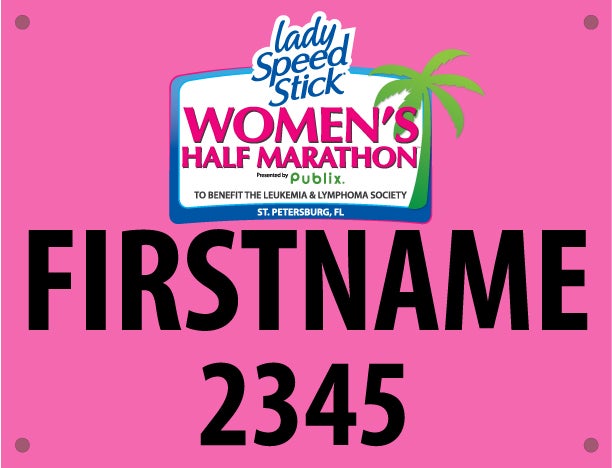New perk! Get after it with local recommendations just for you. Discover nearby events, routes out your door, and hidden gems when you sign up for the Local Running Drop.
So, you’ve committed to running the Lady Speed Stick® Women’s Half Marathon in St. Petersburg on November 18, 2012! Congratulations! Whether this is your first half marathon or your tenth, there are plenty of training plans, tips and advice out there for you. We’ve compiled a few of our own to help get you off and running with the best of them!
Note: Before starting any exercise or fitness programs, always see a physician for a complete physical.
What Type of Half Marathon Runner Are You?
Typically, half marathon runners are grouped into one of four categories, based on experience, level and ability – beginner, intermediate, advanced and run/walker. Below are some helpful hints for each type of half marathon runner to keep your training on-track:
1. Beginner – A runner who has at least a year of experience running on a regular basis and who runs an average of 15 to 20 miles per week.
-Train, train and train some more! Remember practice makes perfect so make sure you train for at least 10-14 weeks prior to the big run date.
-3 days off/4 days on. Rest/cross train three days a week and run the other four days, alternating the days.
-Increase your weekly running mileage. Start gradually increasing your 15-20 miles per week to 18-26 miles per week.
-Increase your weekly long runs. Start at 6 miles and peak at 10 miles.
2. Intermediate – A runner who has several years of experience, may have finished a half-marathon, and regularly runs an average of 25 to 30 miles per week.
-Train, train and train some more! Remember practice makes perfect so make sure you train for at least 10-14 weeks prior to the big run date.
-2 days off/5 days on. Rest/cross train two days a week and run the other five days.
-Increase your weekly running mileage. Start gradually increasing your 25-30 miles per week to 30-40 miles per week.
-Increase your weekly long runs. Start at 7 miles and peak at 13 miles.
-Increase your speedwork. Add hill work and tempo runs.
3. Advanced – A runner who regularly averages 35 miles per week or more for at least six months and has finished at least one half marathon.
-Train, train and train some more! Remember practice makes perfect so make sure you train for at least 10-14 weeks prior to the big run date.
-1 day off/6 days on. Rest/cross train one day a week and run the other six days.
-Increase your weekly running mileage. Start gradually increasing your 35 miles per week to 40-52 miles per week.
-Increase your weekly long runs. Start at 10 miles and peak at 15 miles.
-Increase your speedwork. Add tempo runs and mile repeats.
4. Run/Walker – A run/walker who has at least two months of experience and who run/walks an average of 8-10 miles per week.
-Train, train and train some more! Remember practice makes perfect so make sure you train for at least 10-14 weeks prior to the big run date.
-4 days off/3 days on. Rest/cross-train four days a week and run/walk the other three days, alternating the days.
-Do run/walk intervals. Run for 2-3 minutes and walk for one minute and repeat.
-Increase your weekly running mileage. Start gradually increasing your 8-10 miles per week by adding a mile each week.
-Increase your weekly long runs. Start at 3 miles and peak at 12 miles.
For all half-marathon participants, regardless of experience, level or ability, you’ll want to:
-Make sure you are fit and healthy. Before starting any training plan, always visit your doctor for a complete examination and physical.
-Invest in a good pair of running shoes. Shoes that fit properly are crucial for comfort and injury prevention.
-Run with friends. Find a running partner or join a half marathon training team for inspiration, motivation and support.
-Warm up. Make sure to start each run with a 5-10 minute warm-up walk.
-Cool down. Make sure to finish each run with a 5-10 minute cool-down walk.
-Stretch out. Make sure to finish each run with overall stretching.
Get Your Head in the Game!
Need some inspiration to get your head in the game (or marathon, as the case may be)? Here’s some sure-fire ways to get your half marathon game on:
-Check out our sports medicine programs. Whether you’re a competitive athlete or a weekend warrior, the goal of the St. Anthony’s Sports Medicine Program and the Morton Plant Mease Sports Medicine Program is the same – to provide you with the latest treatments to speed recovery, restore optimal function and keep you in your game.
-Exercise Your Full Potential! BayCare Health System offers three, state-of-the-art Wellness Centers that go beyond aerobics and weight lifting to encompass total wellness – body, mind and spirit.
-Check out the local training teams, coaches and clinics that are highly recommended by Women’s Running Magazine for the best advice, online training, group training and one-on-one personal training in Tampa Bay.
-Subscribe to Women’s Running Magazine, the world’s largest women-specific running magazine.
-Be sure to check out the BayCare Health System booth during the pre-race expo on Friday, November 16 and Saturday, November 17 at the Renaissance Vinoy Resort in downtown St. Petersburg.

